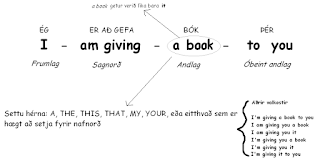 |
| Books by Kuznietsov |
About every three months I tend to gauge my language progress, and then I switch up my learning methods appropriately. This may take place sooner, if need be. Typically, I tend to lean on having 1 good workbook, or self-learning textbook. But these books often do not contain everything you need to learn, and furthermore, the internet has a seemingly endless treasure trove of language resources. So how can one remain minimalistic and focused with so many resources available?
 |
| Diagramming sentences is one of the best things you can do. |
- Before anything else, determine your level. Are you a beginner? Did you just graduate from your intermediate class and you don’t know what to do next? Take a free online assessment test that is as detailed as possible. The European Framework is one standard to go on, and in my opinion, it’s a bit more detailed than the American equivalents.
- Depending on where you are, go ahead and deconstruct the language. Use Tim Ferriss', method for the grammar. In other words – take short sentences that contain different elements of grammar. Diagram them and observe the patterns. You can do the same for vocabulary. Look at nouns, adjectives, verbs and adverbs. What can you tell about them? What is the usual letter range? Are there any sounds you don’t know or can’t make?
- Research resources and pick your choice. These are the four main components of language learning: speaking, writing, reading and listening. You’ll need a resource that can assist you in one or more of these functions.
- Stick to one item at a time. Have one main resource that you learn from. This isn't counting supplements to that source – like a flashcard app for when your own the go. But try not to do a little of each resource. If you take on too much, you may get confused or overburdened with materials.
- Use dictation to your advantage. What I would suggest – for complete minimalism – choose videos or audio-books as your main resource. But take it slow at first, and make sure each item has subtitles or you have the original text. Write down one sentence at a time. Once you finish this, check your work. This will improve listening skills, as well as writing. Focus on the passage you've written down –whether it’s one sentence or ten.
- After it’s corrected, look up any words you don’t know. Diagram the sentences and translated the passages into your native language. This helps with reading and grammar comprehension. Recite the passages to yourself, make flashcards if need be. Then practice using the vocabulary. Try to use the new vocab whenever you speak with someone. And if you don’t have anyone to practice with, try to summarize what you've just listened to and read to yourself out-loud. This exercise should cover all four main categories, and its relatively cost effective.
Invest in a good dictionary and a grammar book. If you plan to learn a language for the long haul, purchase two good reference books. They will aid you immensely – the grammar book more so as a paid resource. You’ll be able to find an answer to any question you may have in terms of verbs, how to construct certain sentences. They will also contain more advanced topics, like how to add emphasis or what words might be exceptions to the rule. If it’s the only thing you buy, get a grammar book for extra help and practice as you learn, especially if you are unfamiliar with grammar terms, or if it’s your first language.
I hope this method helps you. Please let me know what methods you use to master your second language.


No comments:
Post a Comment